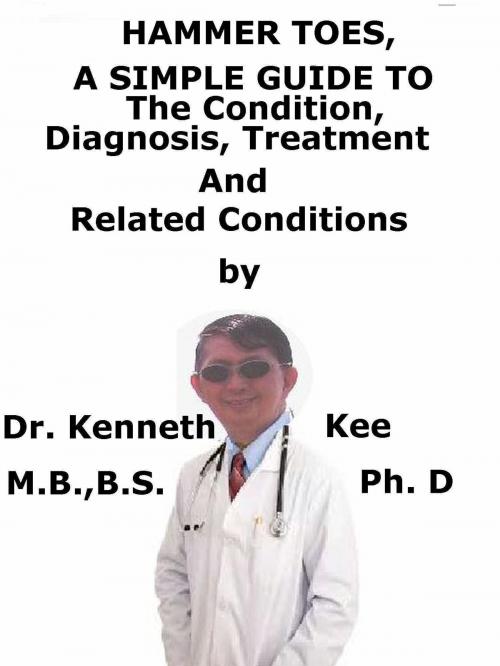Hammer Toes, A Simple Guide To The Condition, Diagnosis, Treatment And Related Conditions
Nonfiction, Health & Well Being, Health, Ailments & Diseases, Musculoskeletal, Medical, Specialties, Orthopedics| Author: | Kenneth Kee | ISBN: | 9781370241903 |
| Publisher: | Kenneth Kee | Publication: | December 12, 2016 |
| Imprint: | Smashwords Edition | Language: | English |
| Author: | Kenneth Kee |
| ISBN: | 9781370241903 |
| Publisher: | Kenneth Kee |
| Publication: | December 12, 2016 |
| Imprint: | Smashwords Edition |
| Language: | English |
Hammer toe is a medical deformity of the toe in which the end of the toe is bent downward.
Hammer toes (hallux abductovalgus) are frequent painful deformities in the three middle toes where they appear to always be bent.
There are two types of hammer toes:
1. Flexible hammer toes
If the toe can flex at the joint, it is a flexible hammer toe.
That is good, because this is an earlier, less-severe form of the disorder.
2. Rigid hammer toes
If the tendons in the toe are rigid, they may press the joint out of alignment.
At this phase, the toe can not be moved.
This normally means surgery is required to correct the problem.
The most common cause of hammer toe is wearing short, narrow shoes that are too tight.
The toe is pushed into a bent position
Hammer toe tends more to occur in:
1. Women who wear shoes that do not fit properly or have high heels
2. Children who keep wearing shoes they have out-grown
3. The disorder may be present at birth
4. Foot injuries
There are three main causes:
1. Genes
2. Arthritis rheumatoid especially
3. Injury to toe
Symptoms
1. The middle joint of the toe is bent.
2. The end part of the toe bends down into a claw-like deformity.
3. Initially, the patient may be able to move and straighten the toe.
Over a period of time, the patient will not be able to move the toe.
4. A corn often forms on the top of the toe.
5. A callus develops on the sole of the foot.
6. Walking or wearing shoes can be painful.
A physical examination of the foot indicates that the patient has hammer toe
Normally an X-ray is part of this examination to evaluate the extent of the disorder.
It may show the extent of the deformity more clearly
There are several treatment methods
1. Properly fitting shoes should be worn, not necessarily expensive shoes.
2. Padding any prominent areas around the bony point of the toe may help to relieve pain.
3. Medicine that reduces inflammation can ease the pain and swelling.
4. Sometimes a doctor will use cortisone injections to help alleviate the acute pain.
5. A podiatrist may also custom-make an insert for the patient to wear inside the shoe.
For severe hammer toe, the patient will require a surgery to straighten the joint.
The surgery often requires cutting or moving tendons and ligaments.
Sometimes, the bones on each side of the joint need to be fused or joined together.
TABLE OF CONTENT
Introduction
Chapter 1 Hammer Toes
Chapter 2 Causes
Chapter 3 Symptoms
Chapter 4 Diagnosis
Chapter 5 Treatment
Chapter 6 Prognosis
Chapter 7 Hallux Valgus
Chapter 8 Overlapping Small Toe
Epilogue
Hammer toe is a medical deformity of the toe in which the end of the toe is bent downward.
Hammer toes (hallux abductovalgus) are frequent painful deformities in the three middle toes where they appear to always be bent.
There are two types of hammer toes:
1. Flexible hammer toes
If the toe can flex at the joint, it is a flexible hammer toe.
That is good, because this is an earlier, less-severe form of the disorder.
2. Rigid hammer toes
If the tendons in the toe are rigid, they may press the joint out of alignment.
At this phase, the toe can not be moved.
This normally means surgery is required to correct the problem.
The most common cause of hammer toe is wearing short, narrow shoes that are too tight.
The toe is pushed into a bent position
Hammer toe tends more to occur in:
1. Women who wear shoes that do not fit properly or have high heels
2. Children who keep wearing shoes they have out-grown
3. The disorder may be present at birth
4. Foot injuries
There are three main causes:
1. Genes
2. Arthritis rheumatoid especially
3. Injury to toe
Symptoms
1. The middle joint of the toe is bent.
2. The end part of the toe bends down into a claw-like deformity.
3. Initially, the patient may be able to move and straighten the toe.
Over a period of time, the patient will not be able to move the toe.
4. A corn often forms on the top of the toe.
5. A callus develops on the sole of the foot.
6. Walking or wearing shoes can be painful.
A physical examination of the foot indicates that the patient has hammer toe
Normally an X-ray is part of this examination to evaluate the extent of the disorder.
It may show the extent of the deformity more clearly
There are several treatment methods
1. Properly fitting shoes should be worn, not necessarily expensive shoes.
2. Padding any prominent areas around the bony point of the toe may help to relieve pain.
3. Medicine that reduces inflammation can ease the pain and swelling.
4. Sometimes a doctor will use cortisone injections to help alleviate the acute pain.
5. A podiatrist may also custom-make an insert for the patient to wear inside the shoe.
For severe hammer toe, the patient will require a surgery to straighten the joint.
The surgery often requires cutting or moving tendons and ligaments.
Sometimes, the bones on each side of the joint need to be fused or joined together.
TABLE OF CONTENT
Introduction
Chapter 1 Hammer Toes
Chapter 2 Causes
Chapter 3 Symptoms
Chapter 4 Diagnosis
Chapter 5 Treatment
Chapter 6 Prognosis
Chapter 7 Hallux Valgus
Chapter 8 Overlapping Small Toe
Epilogue















